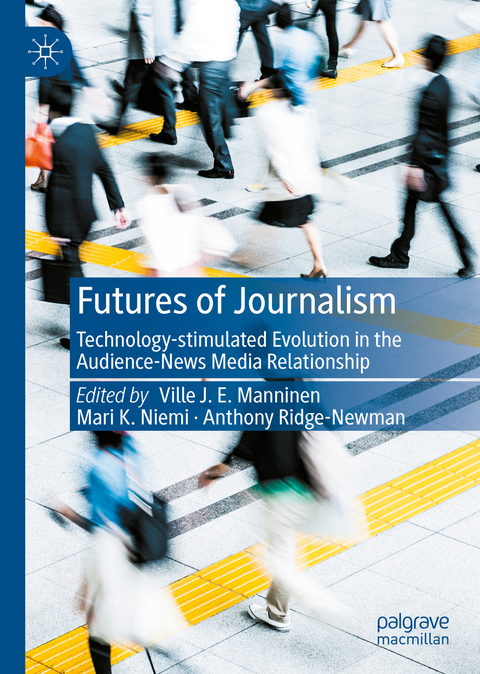
Futures of Journalism
Springer International Publishing (Verlag)
978-3-030-95072-9 (ISBN)
This book examines how technologies are changing, will change, or could change the relationship between audiences and news media. It highlights how novel technologies could have fundamental implications for the way that news media interact with wider society. The book comprises of four thematic parts. Firstly, it focuses on the impact of technological development on the news media business, exploring how news media uses new technologies to improve their sustainability. Secondly, it considers the ethical dilemmas that arise when audience-news media relationships are transformed by technological development. The third part of the book approaches the effects of novel technologies from the journalists' viewpoint: how do new technologies intervene in the audience-news media relationship through journalistic work? Finally, the fourth part dissects the ways new technologies can impact audience-news media relationships through transforming audience agency, audience preferences and news media's understanding of them.
lt;p>Ville J. E. Manninen is a Researcher at the University of Vaasa's InnoLab research platform. He has worked as a researcher and a lecturer at the University of Jyväskylä, focusing on journalistic work practices and media plurality. Ville is a journalism studies graduate and has worked in several newspapers.
Mari K. Niemi is the Research Director of E2 Research, an independent research institute based in Helsinki. She served as the founding Director of the Innovation & Entrepreneurship InnoLab, a research platform at the University of Vaasa. Mari was awarded Academic of the Year in 2015 for her active participation in science communication and public discussion.
Anthony Ridge-Newman is an Associate Professor in Media and Communication at Liverpool Hope University, UK. His research and teaching have been previously based at Glasgow, London, Roehampton and Oxford universities. Anthony has published three books on political communication, and he has diverse scholarly and practice expertise and experience across media, communication and politics.
Introduction.-Section 1: TRANSFORMATIONS IN THE BUSINESS OF JOURNALISM.- Chapter 1. Maintaining online revenues for legacy media.- Chapter 2. Facing the pressure of the market.- Chapter 3. Monetizing attention through blockchain.- Chapter 4. Transmedia storytelling as part of alternative news media business models.- Section 2: ETHICAL IMPLICATIONS OF NEW TECHNOLOGIES.- Chapter 5. Adapting the media self-regulation to the era of news automation.- Chapter 6. News professionals, audiences and communication rights in a global perspective.- Chapter 7. Ethics of newsrooms' knowledge of the users in the era of datafication.- Chapter 8. Potential for artificial intelligence (AI) to rejuvenate public trust in journalism.- Chapter 9. Journalists and the people still known as the audience.- Section 3: ADAPTING JOURNALISTIC PRATICES TO NEW CONDITIONS.- Chapter 10. The changing role of gatekeeping in the age of computational journalism.- Chapter 11. Peer-to-peer journalism in an age of cognitivecapitalism.- Chapter 12. Approaches to improving news commenting with computational moderation.- Chapter 13. Scenarios for how AI can augment citizen involvement in local journalism.- Chapter 14. What happens when platforms mediate the audience-journalism relationship?.- Chapter 15. Networked utilization of satellite images and geospatial technology.- Chapter 16. Troll logic: a challenge to future journalism.- Section 4: UNDERSTANDING CHANGING AUDIENCES.- Chapter 17. Immersive journalism and new audience relationship.- Chapter 18. Perceptions and attitudes towards AI-generated news.- Chapter 19. What drives the news choices of a young audience?.- Chapter 20. Beyond clicks and time spent to authentic engagement.- Chapter 21. The epistemic role of news audiences in a digital era.- Conclusion.
| Erscheinungsdatum | 07.05.2022 |
|---|---|
| Zusatzinfo | XXXI, 373 p. 7 illus. |
| Verlagsort | Cham |
| Sprache | englisch |
| Maße | 148 x 210 mm |
| Gewicht | 657 g |
| Themenwelt | Sozialwissenschaften ► Kommunikation / Medien ► Journalistik |
| Sozialwissenschaften ► Soziologie | |
| Wirtschaft | |
| Schlagworte | AI journalism • Computational Journalism • digital journalism • Immersive Journalism • journalism ethics • journalism technologies • News audiences • news ethics • news funding models • news media business models • punctuated evolution • Technology Ethics |
| ISBN-10 | 3-030-95072-7 / 3030950727 |
| ISBN-13 | 978-3-030-95072-9 / 9783030950729 |
| Zustand | Neuware |
| Haben Sie eine Frage zum Produkt? |
aus dem Bereich


